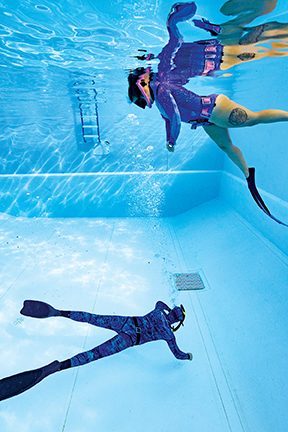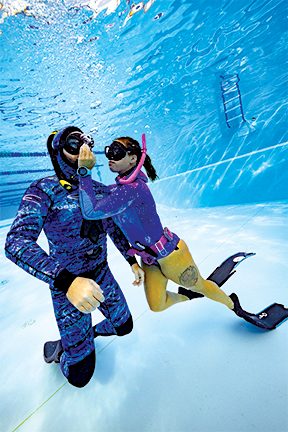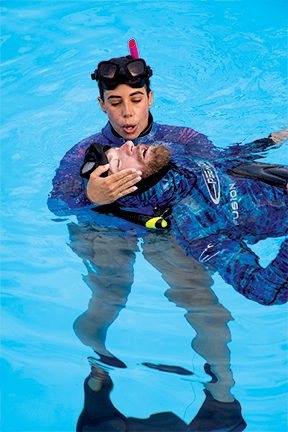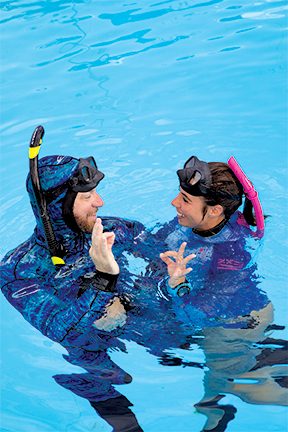THE INSIDIOUS THREAT
“DON’T YOU DO IT. END IT CLEAN. Don’t make me come get you,” I’m muttering under my breath as I kick furiously along a lane line, doing my best to keep pace with the athlete in the water below me. This isn’t my first time as a safety diver in a freediving competition — I know what to expect.
I have learned to read the minute details of each athlete’s technique and interpret the impending risk that arises as they push themselves in pursuit of a personal-best performance. The diver below me has already pushed himself once today. He came up from his static apnea barely able to complete the end-of-dive surface protocol: Breathe, remove mask, signal to the judges, and say “I’m OK.” They gave him a white card, denoting a clean performance, but I know he’s prone to toeing the line of hypoxia.
Now he is kicking along the pool’s tiled lane marker to complete his dynamic bifins target dive. I notice the muscles in his shoulders and the back of his neck tighten and relax. His hands were perfectly stacked when he started the dive, helping him streamline, but now his fingers are trembling as his right hand disconnects from his left, creating drag and slowing him down. He starts to kick more frequently, trying to compensate and maintain his pace as his technique begins to fall apart.
There’s a contraction, and another one, and then bubbles. I duck-dive down to the pool bottom and tell myself the three most important words: “Protect the airway.”
I get him up, drop his weights, and remove his mask. He’s conscious again by the time I make it through two “tap-blow-talks,” and I’ve got a second safety diver helping me get him to the pool edge. “I’m OK,” he says as he tries to remove his mask, which now lies 6 feet below us.
This incident is just one of many encounters I’ve had with freediving blackouts. They usually happen in competition or training, where the divers know they can trust their safeties. But blackouts can occur anytime and in any body of water if a diver pushes their limits. It can have tragic consequences if it happens in open water while alone.
Some recreational divers have near-death or fatal blackout incidents while freediving and spearfishing. The divers are usually overexerted, overweighted, and undersupervised.
Formal training can help to combat those issues. A simple two-day course will teach you valuable safety skills such as proper weighting and rescues and help hone your technique, allowing you to move through the water with maximum output and minimum effort. Perhaps most importantly, you’ll learn the value of always diving with a trained buddy.
When diving recreationally, whether in a pool or open water, you should have just as much trust in your safety. They will have your life in their hands if things go wrong. Everyone involved should be confident and comfortable with the four Rs of blackout rescues:
1. Recognize. This is the first and most challenging part of a rescue. Each diver is different, but as you dive more frequently with your buddy, you’ll learn their technique and what a safe and comfortable dive looks like for them. You get to know how they hold their technique together, where they typically hold their speargun as they surface, or how long they usually stay at specific depths. Based on those observations, you can look for changes in body language, facial expressions, and other signs such as cyanosis (blue lips).
You’ll soon get unmistakable signs if you ignore or can’t see the initial warnings. Remember the phrase “big bubbles mean big troubles.” Bubbles, specifically in a large release from the mouth, are the universal sign of a blackout.
2. Retrieve. Quickly and effortlessly retrieving your buddy gives them the best chance of survival. A freediving course will teach you the most efficient way to perform underwater retrieval, but protecting your buddy’s airway is crucial. Any water in the airway will make the remainder of the rescue much more complicated and lower their chance of survival.
3. Revive. You should do everything in freediving with intention, even the rescues. It is about maximum output with minimum effort. The “tap-blow-talk” method may seem simple, but most agencies consider it the most effective way to bring someone back to consciousness following a blackout.
4. Recover. I mentioned that my diver already had a close call with hypoxia earlier in the day. This previous complication put him at a significantly greater risk for a second incident. While the competition had different standards, I’m rigid about that risk recreationally and in my diving. If you lose motor control or have a blackout, you’re done for the day and out of the water for at least 24 hours to give your system time to recover fully.
The next time you dive, ask yourself if you trust your buddy to protect your airway. Proper training can save a life — possibly yours. AD




© Alert Diver — Q3 2023